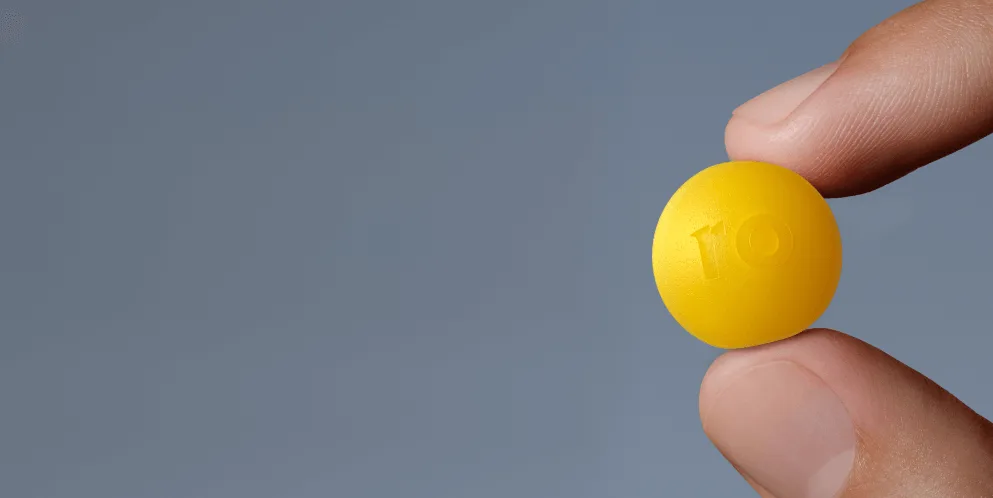Key takeaways
While an enlarged prostate and erectile dysfunction (ED) can often be experienced together, researchers have yet to establish if an enlarged prostate directly causes ED.
Common causes of an enlarged prostate include BPH, prostatitis, and prostate cancer; treatments for these conditions may lead to ED.
Here's what we'll cover
Here's what we'll cover
Key takeaways
While an enlarged prostate and erectile dysfunction (ED) can often be experienced together, researchers have yet to establish if an enlarged prostate directly causes ED.
Common causes of an enlarged prostate include BPH, prostatitis, and prostate cancer; treatments for these conditions may lead to ED.
An enlarged prostate and erectile dysfunction (ED) often go hand in hand. After all, they are both more likely to occur as you get older. But the question still remains: can an enlarged prostate cause ED?
Ahead, we dig deeper into the relationship between prostate issues and ED and explain whether an enlarged prostate can cause ED as well as other penile issues.
What is the function of the prostate?
A little bio 101: The prostate is a reproductive gland that sits under the bladder and between the butt and penis in people assigned male at birth (for the sake of this article, men). Its main role is to produce and secret prostatic fluid, which transports sperm cells and keeps them healthy. When someone ejaculates, the prostate muscles contract. This releases prostatic fluid into the urethra, where it combines with sperm cells and other components to make semen.
Despite being commonly described as chestnut- or walnut-sized, the prostate is only this small for men in their 20s. The gland grows as you get older, measuring about the size of a lemon by the time you hit your 60s. While some increase in size is generally normal, it’s possible for a prostate to become too large, which can cause some problems. So, how do you know if your prostate is enlarged? Glad you asked…
Symptoms and causes of an enlarged prostate
An enlarged prostate can be identified via a rectal exam. During this assessment, a provider typically places a gloved finger inside the rectum to examine the prostate for tenderness, size, and irregularities. If needed, they may also order additional tests, such as a PSA blood test or an ultrasound of the grand and urinary tract—both of which are used to screen for prostate cancer.
Now, there’s no denying that hearing about the big “C” can be nerve-wracking, especially if you think you have an enlarged prostate. But let’s be very clear: While prostate cancer can potentially be to blame, the most common cause of an enlarged prostate is benign prostatic hyperplasia (BPH), which is non-cancerous growth of the prostate tissue and considered a normal part of aging.
All that’s to say, there are a few different reasons for an enlarged prostate and each can come with its own set of symptoms.
Benign prostatic hyperplasia (BPH)
As mentioned above, prostate tissue naturally grows as you get older. BPH is when this growth results in an enlarged prostate. Research suggests it affects up to 60% of men in their 60s and up to 90% of those beyond their 70s. Researchers are unsure why BPH occurs, though hormonal changes may be to blame. Certain factors can also increase the chances of developing BPH, such as genetics, obesity, type 2 diabetes, among others.
It’s important to note BPH is not prostate cancer and does not increase someone’s chance of developing it.
That’s not to say that BPH is all rainbows and butterflies. The condition can cause a range of symptoms, many of which can be uncomfortable, decrease sexual satisfaction, and lower overall quality of life.
Common symptoms of BPH include:
Pain or straining during urination
Frequent and/or sudden need to urinate
Urinating more often at night
Incomplete emptying of the bladder
Weak, slow, or delayed urine stream
Dribbling at the end of urination
Sometimes BPH can lead to more severe complications, such as:
Bladder stones and obstruction
Blood in urine
Inability to urinate
Kidney damage
Urinary tract infection (UTI)
Prostatitis (which can also cause an enlarged prostate, but more on that later)
Prostate Cancer
As its name implies, prostate cancer is a form of cancer that impacts the tissue of the prostate. It affects 1 in 8 men, according to the American Cancer Society. Despite its prevalence, the overall 5-year survival rate of prostate cancer can be fairly high, especially when the disease is caught early. (Just another reason you should ask your healthcare provider about routine screening, which should be highly individualized based on age and other factors.)
In its beginning stages, prostate cancer typically doesn’t cause symptoms. When symptoms do arise, they can involve fatigue. Symptoms can also be a result of the growing prostate—aka an enlarged prostate—pushing on other nearby structures, such as the urethra. This can lead to lower urinary tract symptoms (LUTS) that are similar to those of BPH: frequent or urgent need to urinate, difficulty urinating, and discomfort or pain while urinating. Symptoms can also include blood in urine in more advanced stages of the disease.
Overall, if you are having lower urinary tract symptoms, it’s best to let your healthcare provider know so they can check to make sure your health is in good shape.
Prostatitis
Prostatitis, or inflammation of the prostate, can be another reason for an enlarged prostate. It impacts about 10-14% of men in the US and can be broken down into the following types:
Acute and chronic bacterial prostatitis occurs as a result of a bacterial infection in the prostate. The acute type happens suddenly and is short-lived, and the chronic version gradually develops overtime and lasts longer. Both can cause fever, chills, pain, and LUTS (think: frequent and urgent urination).
Chronic nonbacterial prostatitis or inflammatory pelvic pain syndrome is not as well understood. It may be related to a persistent low-grade infection that’s difficult to detect, inflammation in the area, or damage/changes to local nerves, but the exact cause of the condition is still unknown. It’s characterized by pain or discomfort between the scrotum and anus, in the central lower abdomen, in the penis, scrotum, and/or in the lower back that lasts for three or more months.
So, can an enlarged prostate cause ED?
Now that we’ve covered a few of the common causes of an enlarged prostate, it’s time to get back to the question at hand: can an enlarged prostate cause ED?
Unfortunately, the answer isn’t clear-cut. Whether or not an enlarged prostate might lead to sexual dysfunction can depend on what's causing the enlarged prostate in the first place.
Let’s start with BPH: A 2020 scientific review suggests that BPH and related lower urinary tract symptoms are “closely related” to the “decline of erectile function.” While this doesn’t necessarily mean BPH directly causes ED, it’s worth noting that both conditions share similar risk factors—namely, age. As you get older, you’re more likely to experience ED as well as BPH. So, it could be a bit of a chicken-or-the-egg scenario.
It’s also possible that certain medications that used to treat BPH, such as 5-alpha-reductase (5-AR) inhibitors, can be to blame for sexual dysfunction. Take, for example, Proscar, a type of 5-AR inhibitor often prescribed for BPH. The prescribing information for this medication lists “trouble getting or keeping an erection (impotence)” as a possible side effect. Plus, numerous studies have found ED to be a possible side effect of 5-AR inhibitors at varying percentages.
Surgery, be it for BPH or prostate cancer, might also be what’s behind any sexual dysfunction. The procedural treatment for BPH is known as transurethral resection of the process (TURP), which is essentially a fancy name for removing part of the prostate. TURP has been linked to increased risk of sexual problems, including a decreased sex drive and ED. And the same can be said of a prostatectomy, which involves removing part—a simple prostatectomy—or all—a radical prostatectomy—of the gland. According to a 2016 review, up to 85% of men who’ve had their entire prostate removed experience problems with erections post-surgery.
So, what about an enlarged prostate caused by prostatitis? Can that cause ED? The condition has been linked to an increased chance of ED, though a causal relationship has yet to be established. It's been hypothesized that the pain associated with prostatitis is what can lead to sexual dysfunction.
Can an enlarged prostate keep you from ejaculation?
An enlarged prostate may cause other sexual problems, including inhibiting ejaculation. One study suggests that almost half of patients with BPH and LUTS experience trouble ejaculating.
Yet, similar to ED, the causation between an enlarged prostate and trouble ejaculating has not been established and, therefore, more research is needed.
That being said, some medications for an enlarged prostate may be to blame if you’re dealing with ejaculation troubles. If you take another look at the prescribing info for Proscar (also known as finasteride, the 5-AR inhibitor we mentioned earlier), you’ll also see “decreased volume of ejaculate” and “ejaculation disorders” included as side effects. If this happens, a healthcare provider might lower the dose, change the prescription, or suggest an alternative treatment.
And, as you can probably guess, surgery for an enlarged prostate can also negatively affect ejaculation. A common side effect of TURP, for example, is a “dry orgasm" or "dry climax" (retrograde ejaculation), wherein little to no semen leaves the penis during ejaculation and instead, flows into the bladder. Although dry orgasms are usually not harmful and usually don’t affect sexual pleasure, they can reduce fertility.
How to treat ED issues from an enlarged prostate
As if dealing with an enlarged prostate wasn’t already enough, adding ED into the mix can be, well, a lot. The good news? ED can be fairly simple to address, and often begins with medications, such as Viagra (sildenafil) or Cialis (tadalafil). These two drugs—along with Stendra (avanafil), and Levitra (vardenafil)—are part of a drug class known as phosphodiesterase type 5 (PDE5) inhibitors. At their most basic, PDE5 inhibitors work by increasing blood flow to the penis during arousal to give you harder erections.
You can also experience the effects of PDE5 inhibitors through other formulations (read: not pills). Ro Sparks, for example, dissolves under the tongue and contains both tadalafil and sildenafil (the active ingredients in Cialis and Viagra) to deliver fast-acting ED treatment. And then there are Ro’s Daily Rise Gummies, which feature 7 mg of tadalafil in each fruit-flavored gummy.
In addition to treating ED, tadalafil is also approved to treat BPH. So, depending on your diagnoses, you may be able to address both down there difficulties, depending on your diagnoses and guidance from your healthcare provider. Speaking of which, it’s important to consult your healthcare provider if you think you might be experiencing an enlarged prostate, ED, and/or ejaculation troubles. They can help you determine what might actually be causing your symptoms and develop a treatment plan so you can get back to optimal health.
In addition to prescription medications, certain lifestyle changes may also help address any sexual dysfunction you might be experiencing. Exercising regularly, following a healthy diet, and getting ample, good-quality sleep are just three habits that can alleviate ED (and, ya know, better your overall wellbeing).
Viagra Important Safety Information: Read more about serious warnings and safety info.
Cialis Important Safety Information: Read more about serious warnings and safety info.
Bottom line
It’s clear a correlation exists between the two conditions and that some treatments may work for both, but researchers have yet to determine if an enlarged prostate can directly cause ED. If you’re experiencing symptoms similar to those of an enlarged prostate, dealing with sexual dysfunction, or both, be sure to consult a healthcare provider.
DISCLAIMER
If you have any medical questions or concerns, please talk to your healthcare provider. The articles on Health Guide are underpinned by peer-reviewed research and information drawn from medical societies and governmental agencies. However, they are not a substitute for professional medical advice, diagnosis, or treatment.
American Cancer Society-a. (2024). About Prostate Cancer. Retrieved from https://www.cancer.org/content/dam/CRC/PDF/Public/8793.00.pdf
American Cancer Society-b. (2024). Survival Rates for Prostate Cancer. Retrieved from https://www.cancer.org/cancer/types/prostate-cancer/detection-diagnosis-staging/survival-rates.html
Canguven, O. & Burnett, A. L. (2008). The effect of 5 alpha-reductase inhibitors on erectile function. Journal of Andrology, 29(5), 514–523. doi.org/10.2164/jandrol.108.005025. Retrieved from https://onlinelibrary.wiley.com/doi/full/10.2164/jandrol.108.005025
Cho, J. W. & Duffy, J. F. (2019). Sleep, Sleep Disorders, and Sexual Dysfunction. The World Journal of Men's Health, 37(3), 261–275. doi: 10.5534/wjmh.180045. Retrieved from https://www.ncbi.nlm.nih.gov/pmc/articles/PMC6704301/
Couteau, N., Duquesne, I., Frédéric, P., et al. (2021). Ejaculations and benign prostatic hyperplasia: An impossible compromise? A comprehensive review. Journal of Clinical Medicine, 10(24), 5788. doi: 10.3390/jcm10245788. Retrieved from https://www.ncbi.nlm.nih.gov/pmc/articles/PMC8704358/
Das, A. K., Leong, J. Y., & Roehrborn, C. G. (2019). Office-based therapies for benign prostatic hyperplasia: a review and update. Canadian Journal of Urology, 26(4), 2-7. Retrieved from https://pubmed.ncbi.nlm.nih.gov/31481142/
Emanu, J. C., Avildsen, I. K., & Nelson, C. J. (2016). Erectile dysfunction after radical prostatectomy: prevalence, medical treatments, and psychosocial interventions. Current Opinion in Supportive and Palliative Care, 10(1), 102–107. doi: 10.1097/SPC.0000000000000195. Retrieved from https://www.ncbi.nlm.nih.gov/pmc/articles/PMC5005072/
Federal Drug Administration. Label: Viagra (sildenafil citrate) tablets. Retrieved from https://www.accessdata.fda.gov/drugsatfda_docs/label/2014/20895s039s042lbl.pdf
Foster, H. E., Dahm, P., Kohler, T. S., et al. (2019). Surgical Management of Lower Urinary Tract Symptoms Attributed to Benign Prostatic Hyperplasia: AUA Guideline Amendment 2019. Journal of Urology, 202(3), 592-598. doi: 10.1097/JU.0000000000000319. Retrieved from https://pubmed.ncbi.nlm.nih.gov/31059668/
Franco, J. V., Turk, T., Jung, J. H., et al. (2018). Non-pharmacological interventions for treating chronic prostatitis/chronic pelvic pain syndrome. The Cochrane Database of Systematic Reviews, 12(5), CD012551. doi: 10.1002/14651858.CD012551.pub3. Retrieved from https://pubmed.ncbi.nlm.nih.gov/29757454/
Gandhi, J., Weissbart, S. J., Smith, N. L., et al. (2017). The impact and management of sexual dysfunction secondary to pharmacological therapy of benign prostatic hyperplasia. Translational Andrology and Urology, 6(2), 295-304. doi: 10.21037/tau.2017.03.57. Retrieved from https://www.ncbi.nlm.nih.gov/pmc/articles/PMC5422692/
Kim, S. W. (2011). Prostatic disease and sexual dysfunction. Korean Journal of Urology, 52(6), 373–378. doi: 10.4111/kju.2011.52.6.373. Retreived from https://www.ncbi.nlm.nih.gov/pmc/articles/PMC3123811/
Ko, W. J., Han, H. H., Ham, W. K., & Lee, H. W. (2017). Daily use of sildenafil 50mg at night effectively ameliorates nocturia in patients with lower urinary tract symptoms associated with benign prostatic hyperplasia: an exploratory multicenter, double-blind, randomized, placebo-controlled study. The Aging Male, 20(2), 81-88. doi: 10.1080/13685538.2016.1204290. Retrieved from https://pubmed.ncbi.nlm.nih.gov/28590828/
Krieger, J. N., Lee, S. W., Jeon, J., et al. (2008). Epidemiology of prostatitis. International Journal of Antimicrobial Agents, 31 Suppl 1(Suppl 1), S85–S90. doi: 10.1016/j.ijantimicag.2007.08.028. Retrieved from https://www.ncbi.nlm.nih.gov/pmc/articles/PMC2292121/
Leslie, S. W, Soon-Sutton, T. L, Anu, R. I., et al. (2024). Prostate Cancer. StatPearls. Retrieved from https://www.ncbi.nlm.nih.gov/books/NBK470550/
Ma, C., Su, H., & Li, H. (2020). Global research trends on prostate diseases and erectile dysfunction: A bibliometric and visualized study. Frontiers in Oncology, 10, 627891. doi: 10.3389/fonc.2020.627891. Retrieved from https://www.ncbi.nlm.nih.gov/pmc/articles/PMC7908828/
National Cancer Institute (NCI). (2024). Understanding Prostate Changes and Conditions. Retrieved from https://www.cancer.gov/types/prostate/understanding-prostate-changes
National Institute of Diabetes and Digestive and Kidney Diseases (NIDDK-a). (n.d.). Enlarged Prostate (BPH). Retrieved from https://medlineplus.gov/enlargedprostatebph.html
National Institute of Diabetes and Digestive and Kidney Diseases (NIDDK-b). (n.d.). Prostatitis: Inflammation of the Prostate. Retrieved from https://www.niddk.nih.gov/health-information/urologic-diseases/prostate-problems/prostatitis-inflammation-prostate
National Institute of Health (NIH). (2022). In brief: How does the prostate work? Retrieved from https://www.ncbi.nlm.nih.gov/books/NBK279291/
Ng, M., Leslie, S. W., & Baradhi, K. M. (2024). Benign Prostatic Hyperplasia. StatPearls. Retrieved from https://www.ncbi.nlm.nih.gov/books/NBK558920/
Russo, G. I., Bongiorno, D., Bonomo, C., et al. (2023). The relationship between the gut microbiota, benign prostatic hyperplasia, and erectile dysfunction. International Journal of Impotence Research, 35, 350-355. Retrieved from https://www.nature.com/articles/s41443-022-00569-1.
Russo, G. I., Broggi, G., Cocci, A., et al. (2021). Relationship between dietary patterns with benign prostatic hyperplasia and erectile dysfunction: a collaborative review. Nutrients, 13(11), 4148. https://doi.org/10.3390/nu13114148. Retrieved from https://www.mdpi.com/2072-6643/13/11/4148
Silva, A. B., Sousa, N., Azevedo, L. F., & Martins, C. (2017). Physical activity and exercise for erectile dysfunction: systematic review and meta-analysis. British Journal of Sports Medicine, 51(19), 1419–1424. doi: 10.1136/bjsports-2016-096418. Retrieved from https://pubmed.ncbi.nlm.nih.gov/27707739/
Stratton, K. (2023). Enlarged prostate. National Library of Medicine. Retrieved from https://medlineplus.gov/ency/article/000381.htm
U.S. Food and Drug Administration (FDA). (2013). Highlights of Prescribing Information: Proscar (finasteride) Tablets. Retrieved from https://www.accessdata.fda.gov/drugsatfda_docs/label/2014/020180s044lbl.pdf












